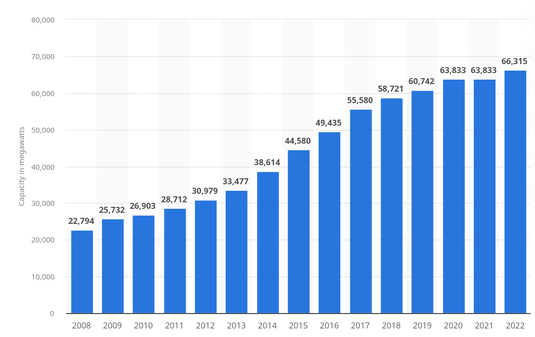Growth in german wind capacity is slowing. Soo… then the plan is to keep on with lignite and gas? Am I missing something?
Installed Wind Capacty - Germany

Growth in german wind capacity is slowing. Soo… then the plan is to keep on with lignite and gas? Am I missing something?
Installed Wind Capacty - Germany

Absolute bullshit. HVDC cable power loss is between 0.3% and 1% per 100km. And when it comes to UHVDC, a typical loss for 800 kV lines is 2.6% over 800 km. Transformers and substations cause a power loss of around 0.5% to 2%.
https://www.nationalgrid.com/sites/default/files/documents/13784-High Voltage Direct Current Electricity – technical information.pdf
https://ieeexplore.ieee.org/document/6761670
By the way, even with your completely wrong, off by a factor of ten numbers, renewables with that transmission loss would still still cheaper than nuclear, safer than nuclear, and quicker to provision than nuclear. Sucks to suck.
It bothers me that you want to educate people but you are being so combative and smug. This isn’t the way to change people’s minds. All you are doing is making people feel personally attacked and driving them further away from having an open mind.
This is the first I’ve heard of HVDC, my experience is with typical AC transmission that makes up most of the current grid. Not a lot of experience, but college physics level.
US high voltage transmission is usually AC in one of the following voltages: 345 kV, 500 kV, or 765 kV. I used the 765 kV worst case losses of 1.1% per 100 miles (according to American Electric Power Transmission Facts Q12) which is over generous since most transmission would likely not be using only the high efficiency lines.
Also, transmission range is affected by load and high load reduces line capability.
We’re talking about moving a huge amount of power across 3000 miles. In my experience transmitting power across a nation as large as the US is unheard of.
You also seemed to have missed my point about how much excess power would be required to power the opposite side of the country (in the dark) while basically at dusk. Let’s say 30% of the east coast’s power comes from solar. That would mean that the West Coast would need to provide that 30% excess on top of their current energy demands during a relatively high demand time period. It would also be a bit unfair for the West Coast to be the ones responsible for over-provisioning to accommodate the east coast.
Is HVDC even installed and able to transmit across the US now?